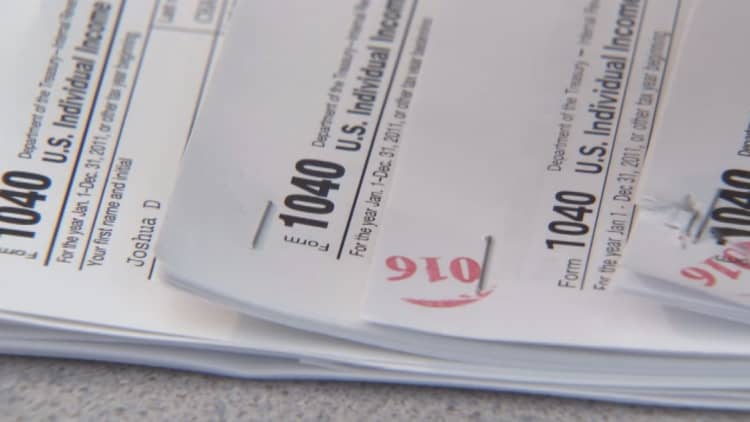
Enjoy that bump in pay thanks to the new tax law, because some earners may find themselves on the hook for more taxes in 2019.
In January, the Treasury Department released its income tax withholding tables, updated to reflect changes stemming from the Tax Cuts and Jobs Act. The new legislation cut individual income taxes, raised the standard deduction and eliminated personal exemptions.
You may begin seeing changes to your paycheck as early as this month.
The IRS is still working on an update to a key form — the W-4 — that determines the amount of income tax withheld from your pay based on a number of crtieria, including whether your spouse works, whether you have children and whether you itemize.
If you withhold too much, you'll be due a refund the following year. Fail to withhold an adequate amount, and you'll owe the taxman (and possibly penalties.)
That means certain taxpayers, particularly high-income earners and those who have itemized on their taxes, may need to revisit their W-4 or else risk owing the IRS in 2019.
Here's how to determine whether you're at risk for owing more taxes next year.
Fatter paychecks
"Most people will probably see more net after-tax wages coming home to them, but the concern is whether the proposal will adequately cover taxes for 2018," said Michael D'Addio, a principal at Marcum in New Haven, Connecticut.

He said that as many as half of his clients are withholding an insufficient amount of taxes based on the new table. They may be short by $4,000 to $5,000, according to D'Addio.
"We've had clients take additional withholding," he said. "People would be well-advised to look at their situation and determine whether they are underwithheld."
Heads up, itemizers
How much income tax is deducted from your paycheck depends on the number of allowances you claim on Form W-4.
The more allowances you claim — for your spouse and your dependents — the less tax will be withheld from your pay. You can also withhold fewer taxes if you claim itemized deductions.
There's the catch: The new law does away with a wide swath of itemized deductions and places a $10,000 cap on state and local tax deductions.
In general, fewer filers are expected to itemize in 2018 because the new tax law has doubled the standard deduction. Under the previous law, about 49 million taxpayers — roughly 3 in 10 individuals — filed itemized returns, according to the Urban-Brookings Tax Policy Center.
If you fall into that category, you may need to update your allowances to ensure you're withholding the right amount of tax.
"There are people who were itemizers, but now they don't make the threshold," said Lisa Greene-Lewis, a certified public accountant with Turbo Tax. "If you itemize, look at revisiting your W-4 and your personal allowances."
The same goes for families with children.
Although the new law doubled the child tax credit to $2,000, personal and dependent exemptions are gone. If you claimed allowances for your kids, revisit your W-4.
"Anyone who has kids, we know those personal exemptions are going away, so how does that impact your personal allowances, even with the doubled child tax credit?" asked Greene-Lewis.
Higher income
Most taxpayers may end up with about the same status or slightly overwithheld under the new tables, but higher-income individuals should take a second look, said Cari Weston, director of tax practice and ethics at the American Institute of Certified Public Accountants.
"Those in the income range of $200,000 to $500,000 may be impacted negatively or underwithheld," she said.
That's because the individual income tax rates changed for those filers from 2017 to 2018, bumping some of them into higher brackets.
"More of their income is taxed at the next higher marginal rate than last year," said Weston.
For instance, last year, single individuals with taxable income of $191,650 to $416,700 were in the 33 percent bracket. This year, many of those filers will be in the 35 percent bracket, which applies from $200,000 to $500,000 of taxable income.
See below for the new tax brackets for single filers.
| Rate | Taxable Income Bracket |
|---|---|
| 10% | 0 to $9,525 |
| 12% | $9,525 to $38,700 |
| 22% | $38,700 to $82,500 |
| 24% | $82,500 to $157,500 |
| 32% | $157,500 to $200,000 |
| 35% | $200,000 to $500,000 |
| 37% | $500,000 and up |
These are the new brackets for married filing jointly.
| Rate | Taxable Income Bracket |
|---|---|
| 10% | 0 to $19,050 |
| 12% | $19,050 to $77,400 |
| 22% | $77,400 to $165,000 |
| 24% | $165,000 to $315,000 |
| 32% | $315,000 to $400,000 |
| 35% | $400,000 to $600,000 |
| 37% | $600,000 and up |
"Don't just look at the lower tax rate; look at the minimum and maximum income ranges and how they're taxed," said Weston.
Further, those taxpayers are more likely to have itemized in previous years, meaning they are grappling with the same loss of deductions.
As you set up your appointment with your CPA to file your taxes, it won't hurt to ask how this year's withholding updates might affect your taxes next year.
"It's not a bad idea to ask if you can take last year's return and run a quick projection at next year's rates," Weston said. "It's worth your time to do it and get an idea so there are no surprises at the end of the year when it's too late."
More from Personal Finance:
Residents in this city owe the IRS more than $7,000 come tax time
The GOP tax bill lets you take this break even on 2017 taxes
It's tax season: How to make filing relatively painless


